Tillandsia fuchsii var. fuchsii
Click thumbnails for full size, scaled to a new window.
Tillandsia fuchsii var. fuchsii
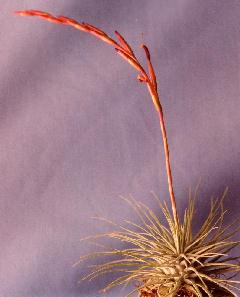
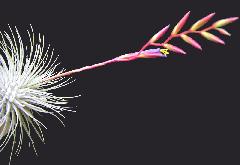
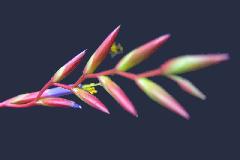
| Ken Woods 10/04 |
Ken Woods 12/09 |
Chris Larson ... "The Guatemalan trade still uses the name T. argentea for T. fuchsii var gracilis. T. argentea is rare and difficult to grow except possibly in Cairns. I'd love to know if it is OK in brisbane?"
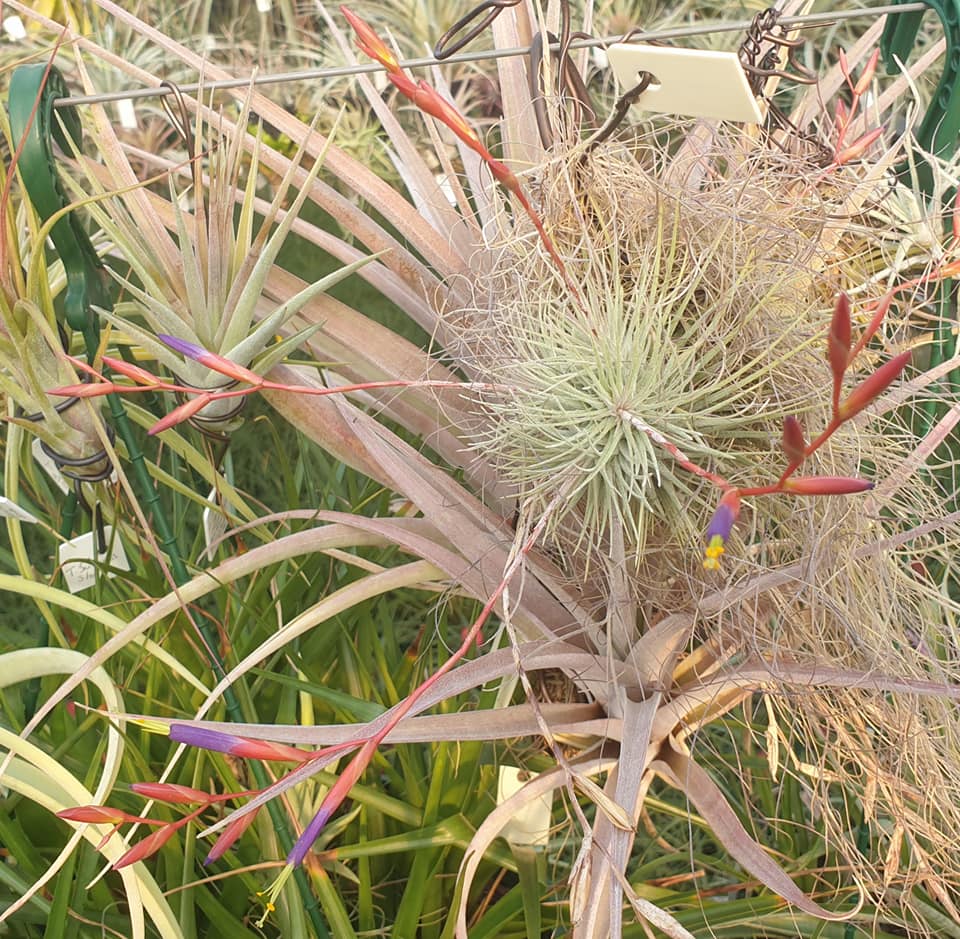
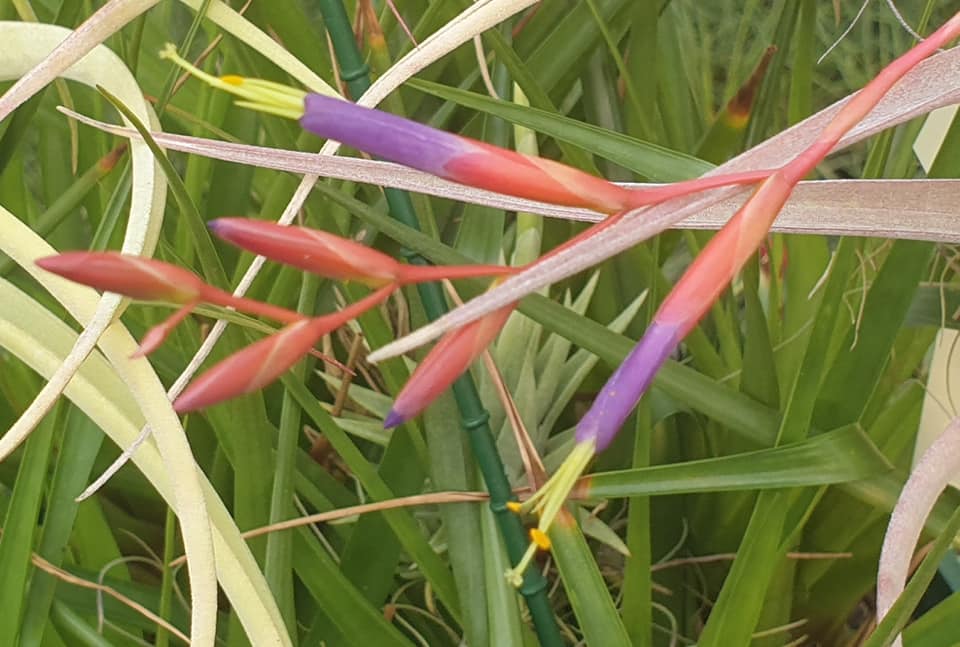
Tillandsia fuchsii W. Till. sp. nova, Die Bromelie 2/1990 p 30
See also J. Brom. Soc. 42: 99-102. 1992
Plant stemless.
Leaves globular rosette, (7-) 10 ( -17) cm diam., 5-8 cm long.
Sheath 8 x 6 (12 x13!) mm, with almost parallel membranous edges, the lower 1/3rd thin and glabrous, the upper 2/3rds succulent, the same colour as the blade and densely appressed scaled.
Leaf blade ca. distinct from the sheath, tapering quickly from a short triangular base, linear , stiff, grey green, densely appressed scales, edged, topside not grooved, on the contrary somewhat succulent, above the base 1 – 1.3 ( -4) mm wide, ( 2.3 - ) 4.5 –6 ( -9)cm long,
Scape 5 – 10 ( -14 ) cm long, in a living state 1.4 – 1.5 ( - 3) mm diam., smooth, round stem, stiff erect or some what bent from the base, central, glabrous, dark wine red.
Scape internodes (5-) 6.5 – 10 (-12) mm long,
Scape bracts outside densely scaled, inside glabrous, the lower ones longer than the internodes, with up to 20 mm long, filiform blade, the upper ones as long or shorter than the internodes, tipped, the blade 7 – 10 mm long.
Inflorescence (3 - ) 7.5 – 9.5 ( - 15 )cm long, ( 3- ) 5-10 ( - 14 ) flowered.
Flowers scent-less, spreading from the rhachis, short and very robust stemmed, from the bottom to the stigma lobes up to 4 cm long, and ca. 4 mm diam.
Rhachis smooth, glabrous, half round, winged next to the flower, wine red, Internodes ( 8.5 - ) 9.5 – 10 ( - 13 ) mm long, ( the lower ones mostly longer)
Floral bracts wine red, ovate elliptic, rounded at the tip, smooth when alive, nerved when dry, inside and outside glabrous, 7.5 – 10 .5 x 6 – 7.1 mm, clearly shorter than the sepals, broad membranous edges.
Sepals wine red, smooth when living, nerved when dry, inside glabrous, outside glabrous or the whole with a few scales, not keeled, 1.5 – 2 times as long as the rhachis internodes, narrow elliptic, broad rounded at the tip, anterior free, or connate to 0.8 mm, posterior 1 – 1.5 mm connate, broad membranous edged, 13.3 – 16 x 4.9 – 5.9 mm,
Petals violet, at the base white, 22 – 24.5 mm long, ( 4.5 -) 6.1 –7 mm wide, broad rounded at the tip, and somewhat hooded, forming an erect tube with a light tip,ca. 5mm from the base somewhat constricted, and clearly overlaps the edges, overlaps the stamens by 7 – 12 mm, and the stigma by 10 – 15 mm.
Stamens in 2 unequal rows, the outer ca. 3mm longer than the inner,
Filament yellow green, moderately flat, the tip not or hardly broader,
Anther dorsifix, ( in the middle ), 2- 2.4 ( - 4 ) x 1 – 1.3 mm, dark ochre to greenish brown.
Pollen egg to orange yellow.
Ovary egg shaped conical, pale green, ca. 4 x 2 mm.
Style thin yellow green, ca. 31 x 0.4 – 0.5 mm.
Stigma lobes with top of the style light green, clearly split into 3, papillose, at flowering with a somewhat colourless liquid.
Type locality Mexico, State of Oaxaca, between the towns of Oaxaca and Tehuantepec, ca. 1300 m. 1975 leg. S. Schatzl 75/ 23 ( WU, Holotype ): E. Zecher 1985 s.n. Mexico ( WU, Paratype )
Table I. Comparison of the diagnostic characteristics.
| Tillandsia argentea | Tillandsia fuchsii |
| short-caulescent | stemless |
| leaf sheaths not succulent, castaneous, leaf blades involute at upper surface | leaf sheaths succulent, light green, leaf blades not involute but angled and succulent at base. |
| inflorescence 4 (-6) flowered | Inflorescence 5 – 10 (-14) flowered |
| floral bracts oblong-orbicular, 5.5-6.7 x 5.5-6.2 mm, laxly lepidote outside, with narrow hyaline margins | floral bracts ovate to oval, 7.5 – 10.5 x 6 – 7.1mm, outside normally glabrous, with broad hyaline margins |
| corolla zygomorphic | corolla actinomorphic |
| sepals broadly ovate-elliptic, 12-13.5 (-16) x 6-7.1 mm | sepals narrowly elliptic 13.3 16 x 4.9 – 5.9mm |
| petals crimson, narrowly lanceolate, not constricted above base and unlobed, not hood-shaped at apex, 27-27.5 x 5.1 mm | petals violet, lingulate, somewhat constricted above base and with lateral lobes, distinctly hood-shaped at apex, 22 – 24.5 x 7mm. |
| filaments crimson like the petals | filaments chartreuse |
| style light crimson; stigma at same height as the anthers | style chartreuse; stigma mostly exceeding the longer stamens
|
| distribution: Cuba, Jamaica | distribution: Mexico, Guatemala |
Tillandsia fuchsii forma gracilis W. TILL, forma nov. Die Bromelie 2/1990 p32
A forma typica laminis foliorum perangustis filiformibusque recedit. Chromosomarum numerus n=25 (M. Kiehn, adhuo non publicatus).
Typus: Mexico, Estdo. Chiapas, Dos Lagos, inter San Cristobal de las Casas et Comitan de Dominguez, leg. R. & K. Ehlers EM 82214 (= hort. bot. univ. Vindob. no. B 222/90), anno 1982 (WU, holotypus); Mexico, Estdo. Oaxaca, supra Putla in via ad urbem Tlaxiaco, 1200 m s.m., leg. R. & K. Ehlers s.n. anno 1978 (= hort. bot. univ. Vindob. no. B 221/90) (WU, paratypus); Mexico, Estdo. Chiapas, in jugo prope Motocintla in via ad urbem Tapachula, 1760 m s.m., leg. R. & K. Ehlers EM 891306 anno 1989 (= hort. bot. univ. Vindob. no. B 226/90) (WU, paratypus); Guatemala, prope Huahuatenango, leg. U. Feldhoff s.n. (= hort. bot. univ. Vindob. no. B 224/90) (WU, paratypus); sine loco et collectore, versimiliter Guatemala (WU, paratypus).
Differs from type in
1. Leaf blades narrow filiform.
Tillandsia fuchsii var. stephani W. TILL var. nov. Die Bromelie 2/ 1990 p32
A varietate typica inflorescentia olivacea nec rubra, internodiis rhachidis longioribus, bracteis florigeris et sepalis acutis et stigmatibus violaceis antheris aequilongibus recedit.
Typus: S. Schatzl 77/60, Mexico, Estdo. Jalisco, km 20 in via a Puerto Va!larta ad Manzanillo, anno 1977. (WU, Holotypus); ibidem, km 35, S. Schatzl 77/57 (WU, Para-typus).
Differs from type in
1. Inflorescence greenish brown not red
2. Rhachis internodes longer
3. Floral bracts acute
4. Sepals acute
5. Stigma violet and as long as the anther
From Walter Till in J. Brom. Soc. (42: 99-102. 1992
One of the most beautiful, small tillandsias, much desired by growers, is generally known as Tillandsia argentea. The plants have a bulbous habit because of the succulent leaf bases. The leaves are slender, more or less cylindrical, and tapering to a fine, sharp point (subulate). They are densely covered with a grey, frostlike bloom. The lax, simple inflorescences are coral-colored and bear 5-10 flowers with radially symmetrical violet corollas. They are found on the western side of the Sierra Madre in Mexico and southward as far as Guatemala.
If one reads the different descriptions, red and violet can be found as the color of the petals, but nobody investigated this discrepancy. In addition, the other characters derive from two different taxa and, as a result, all descriptions are a mixture.
Grisebach founded his "Tillandsia argentea" on fruiting material from southeastern Cuba collected by C. Wright in 1859. The type specimen is deposited in the herbarium of the University of Gottingen, Germany. An additional specimen is kept in the herbarium of the Museum of Natural History in Vienna, Austria, and probably also represents a type. Both specimens strongly resemble the habit of the plants collected in Mexico and Guatemala but they do not form bulbs since their leaf sheaths are not succulent. Plants of this kind are found only in Cuba and Jamaica.
In the last few years, living material has been imported by various Austrian and Czechoslovakian collectors from Cuba when that country increased its efforts to attract tourists. The vegetative plants attracted my attention and when they flowered in the greenhouse of the University of Vienna garden it was clear that they were different from the Mexican and Guatemalan plants. A comparison with the type specimen from Gottingen revealed that the living samples were completely identical with Wright's collection of nearly 130 years earlier.
As there are no synonyms under Tillandsia argentea, the mainland plants had to be described as new. I named them in honor of Franz Fuchs, the chief gardener of the Botanical Garden at Linz, Austria, for his merits in cultivating tillandsias and other bromeliads.
Since the plant in question is well known by most growers, it is not necessary to give an extensive description here, but it is introduced by the accompanying illustrations.
Typical plants (fig. 1) are found in the southeast of the state of Oaxaca, Mexico, between the cities of Oaxaca and Tehuantepec at an elevation of about 1300 meters above sea level. They represent the coarse-leafed form. Plants from the Mexican states of Michocan and Guerrero obviously belong also to the typical form.
In the state of Chiapas in southern Mexico and in Guatemala, Tillandsia fuchsii tends to have thinner and more slender leaves. I have described it as forma gracilis.
More striking and interesting is a population from the western part of the state of Jalisco, Mexico, which I have named in honor of the collector, Stefan Schatzl, senior gardener of the Botanical Garden at Linz, as Tillandsia fuchsii variety stephani (fig. 3). It differs from the typical variety by its wine-red to maroon inflorescences, the longer internodes of the rachis, the acute floral bracts and sepals, and the violet stigmas.
That variety settles at the northwestern end of the distribution of T. fuchsii.
It should be noted that Tillandsia fuchsii is endangered since it is over-collected for commercial purposes. Thousands of plants are ruined each year in florist shops where they are stuck on pieces of wood or stone.
They are completely unadaptable to the average apartment climate. Trade in this species should be limited exclusively to material grown from seed by horticulturists.
Key to varieties of T. fuchsii
1 Inflorescence red => 2
1. Inflorescence greenish brown => var stephanii
2. Leaf blades angled and succulent at base => var fuchsii
2. Leaf blades narrow filiform => forma gracilis
Updated 26/10/21




